
Musala ; from Arabic through Ottoman Turkish: from Musalla, "near God" or "place for prayer" is the highest peak in the Rila Mountains, as well as in Bulgaria and the entire Balkan Peninsula, standing at 2,925 metres (9,596 ft). With a topographic prominence of 2,473 metres (8,114 ft), Musala is also the 6th highest peak by topographic prominence in mainland Europe. Musala is also the 3rd most topographically isolated major peak in Continental Europe.
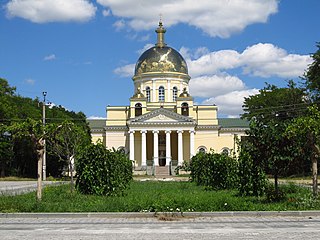
Bolhrad, is a small city in Odessa Oblast (province) of southwestern Ukraine, in the historical region of Budjak. It is the administrative center of Bolhrad Raion (district). Population: 14,962

Belene Island or Persin Island is the biggest island in Bulgarian waters. The island is formed by the Danube River splitting into two branches passing north and south of it. The international frontier between Bulgaria and Romania follows the north branch of the river and therefore Belene Island is part of the Bulgarian territory. The island is 14.5 kilometres (9.0 mi) long and reaching 6 km (3.7 mi) in width; it is located in the Danube, north of the town of Belene. Belene Island is the fourth biggest Danube island: during an average tide it is 41.078 square kilometres (15.860 sq mi) in area. During a high tide, parts of the island are submerged. The island is connected to the town of Belene with a pontoon bridge.
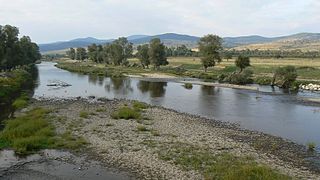
The Topolnitsa (Bulgarian: Тополница [toˈpɔɫnit͡ʃɐ]) is a river in southern Bulgaria, an important left tributary of the Maritsa. It takes its source from Bich Peak in Sredna Gora close to Koprivshtitsa; it is known as the Shirineyska in its upper course. Its average discharge is 55 m³/s and it is 135.6 kilometres (84.3 mi) long; its drainage basin covers 1,780 square kilometres (690 sq mi). The Topolnitsa flows into the Maritsa near Pazardzhik after making a large turn under Trakiya motorway. The Topolnitsa Reservoir has a maximum volume of 120,000,000 cubic metres (4.2×109 cu ft) and serves the area around Pazardzhik. Among the Topolnitsa's tributaries are the Mativir and the Bunovo River. The river's name is derived from the Bulgarian word топола, topola ("poplar").

The Saint Sofia Church is the oldest church in the Bulgarian capital Sofia, dating to the 4th century. In the predecessor building took place the Council of Serdica held most probably in 343 and attended by 316 bishops. In the 14th century, the church gave its name to the city, previously known as Serdika (Сердика).

The Seven Rila Lakes are a group of glacial lakes, situated in the northwestern Rila Mountain in Bulgaria. They are the most visited group of lakes in Bulgaria. The lakes are situated between 2,100 and 2,500 metres elevation above sea level.
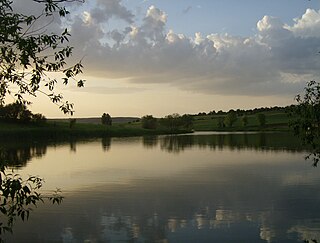
The Ludogorie or Deliorman, is a region in northeastern Bulgaria stretching over the plateau of the same name. Major cities in the region are Targovishte, Razgrad, Dulovo, Novi Pazar, Pliska, Preslav and Isperih. Part of the Danubian Plain, the region is hilly in the east, reaching up to 485.70 metres (1,593.5 ft) in height near the village of Samuil, but merges with the plains of Dobruja and the Danube to the north, with the lowest point near Yuper. The region is bordered to the west by the Provadiya River and the Beli Lom; to the east it transitions into the Dobruja plateau.
The Tsibritsa is a river in the western Danubian Plain of northern Bulgaria and a right tributary of the Danube. The river originates in the Shiroka Planina area of the Fore-Balkan Mountains near the Serbian border and flows in a northeast direction diagonally through Montana Province. East of the village of Dolni Tsibar in Valchedram municipality, it flows into the Danube.
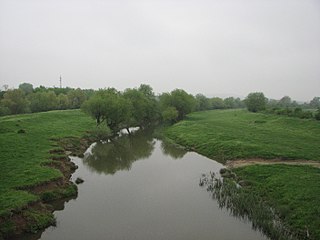
The Sazliyka or Rakitnitsa is a river in southeastern Bulgaria, a left tributary of the Maritsa. It originates in the Sarnena Sredna Gora mountains. In its upper course until Radnevo, it is also known as the Rakitnitsa or Syuyutliyka. The river is 121.7 kilometres in length and has a drainage basin of 3,366 square kilometres. Its average discharge at Galabovo is 17 cubic metres per second. The Galabovo Reservoir is located along the river.
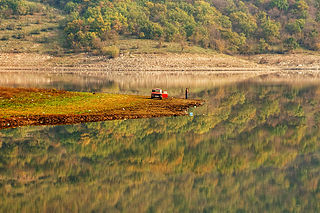
The Aheloy or Achelous is a river in eastern Bulgaria. It originates in the Aytos-Karnobat mountain, 1.5 kilometres from Dryankovets, and flows directly into the Black Sea south of the village of Aheloy. The Aheloy River has a length of 39.9 kilometres and has an irrigation reservoir, the Aheloy Reservoir, built along its flow. The river's drainage basin covers 141 square kilometres and its average discharge is 0.7 cubic metres per second.

Karel Václav Škorpil was a Czech-Bulgarian archaeologist and museum worker credited along with his brother Hermann with the establishment of those two disciplines in Bulgaria.

Václav Hermenegild Škorpil was a Czech-Bulgarian archaeologist and museum worker credited along with his brother Karel with the establishment of those two disciplines in Bulgaria, as well as a geologist, botanist, architect and librarian.

Madara is a village in northeastern Bulgaria, part of Shumen municipality, Shumen Province. Madara lies 15 kilometres (9.3 mi) east of the city of Shumen, at the western foot of the Madara plateau.
Ilia Beshkov Dunov was a Bulgarian painter, graphic artist, comics artist, caricaturist, cartoonist, illustrator, writer and pedagogue.

Václav Dobruský was a Czech archaeologist, epigrapher and numismatist who was mostly active in Bulgaria. The first director of the National Archaeological Museum of Bulgaria from 1893 to 1910, he is regarded as one of the founding fathers of archaeology in that country.

The Georgi Sava Rakovski Bolhrad High School ; Bulgarian: Болградска гимназия „Георги Сава Раковски“, Bolgradska gimnazia „Georgi Sava Rakovski“) is a gymnasium in Bolhrad, Odessa Oblast, southwestern Ukraine. Founded in 1858 at the request of Bolhrad's Bessarabian Bulgarian population, the Bolhrad Gymnasium is regarded as the oldest high school of the Bulgarian National Revival.
Parteniy Pavlovich was a Bulgarian Eastern Orthodox cleric, man of letters and traveller, regarded as one of the precursors of Paisius of Hilendar. A champion of the South Slavic revival, Pavlovich was the author of the first autobiography in South Slavic literature.
Moya Strana, Moya Bălgaria is a patriotic song by Bulgarian singer Emil Dimitrov, issued in 1970. The lyrics of the song were written by Vasil Andreev. It was chosen as "The Song of the Century" in Bulgaria and is considered as an unofficial (second) national anthem of Bulgaria.

Nikola Ivanov Lazarov was a Bulgarian architect.

Ticha Reservoir is a reservoir in Varbitsa Municipality, Shumen Province, northeastern Bulgaria, located to the north and northeast of the town of Varbitsa. It is one of the largest lakes of Bulgaria. The Ticha Dam is located in the northeastern part of the reservoir, in the southeastern part of Kotel Mountain.



















